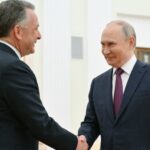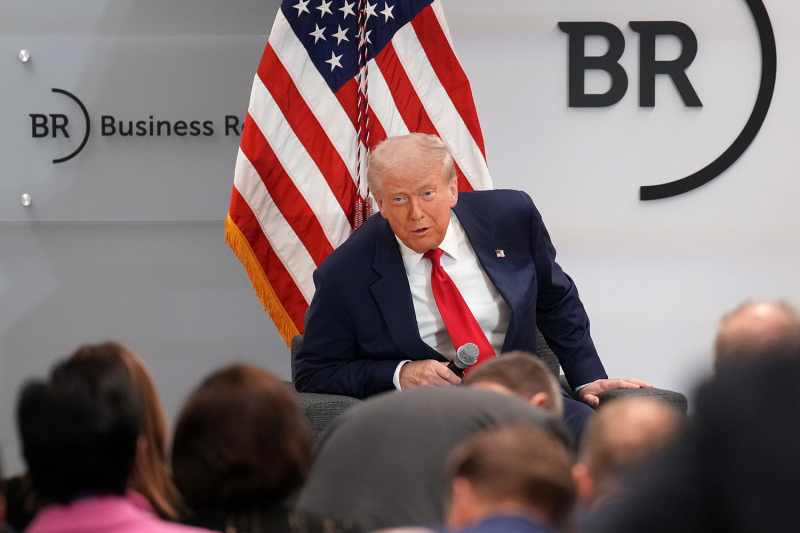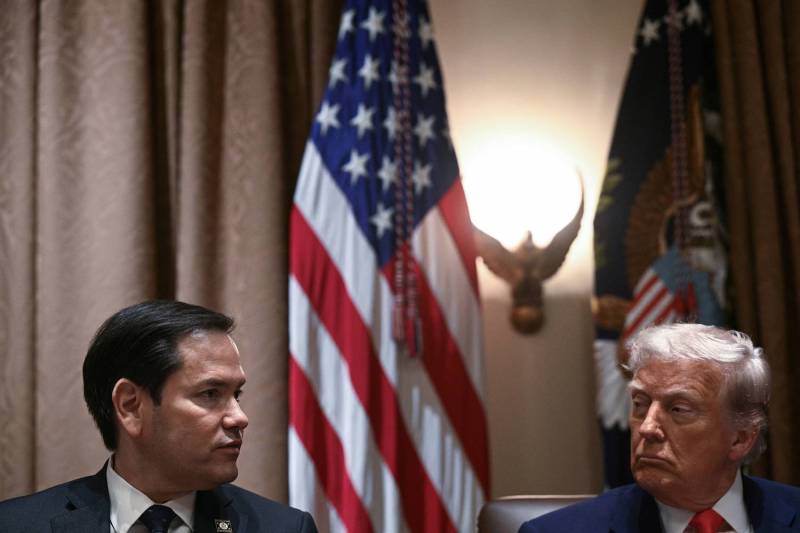India-Pakistan Tensions Reach Six-Year High

India-Pakistan Tensions Reach Six-Year High
Islamabad claims New Delhi is planning military action, raising the question of international mediation.
An Indian paramilitary soldier stands watch near a market in Srinagar, Indian-administered Kashmir, on April 29. Faisal Khan/Middle East Images / Middle East Images/AFP via Getty Images
Welcome to Foreign Policy’s South Asia Brief.
The highlights this week: India-Pakistan tensions reach a high point after a terrorist attack in Kashmir, India and the United States move forward on trade talks, and Mark Carney’s election victory in Canada could bring a fresh start to Ottawa-New Delhi ties.
Welcome to Foreign Policy’s South Asia Brief.
The highlights this week: India-Pakistan tensions reach a high point after a terrorist attack in Kashmir, India and the United States move forward on trade talks, and Mark Carney’s election victory in Canada could bring a fresh start to Ottawa-New Delhi ties.
Who Could Mediate an India-Pakistan Conflict?
Tensions between India and Pakistan remain very high eight days after terrorists killed 26 tourists in Indian-administered Kashmir—a rare attack on civilians that New Delhi has accused Islamabad of sponsoring.
Early on Wednesday local time, Pakistani Information Minister Attaullah Tarar said in a post on X that Pakistan had “credible intelligence” that India was planning “military action against Pakistan in the next 24-36 hours.” On Sunday, the Indian Express cited an anonymous “top source” in the Indian government who said that “there will be military retaliation and we are prepared.”
This week, India and Pakistan have traded tit-for-tat escalations. Clashes between the two countries broke out along their disputed frontier in Kashmir, known as the Line of Control (LoC). On Tuesday, Pakistan said it shot down an Indian drone in Pakistani airspace along the LoC. Over the weekend, the Indian Navy test-fired long-range missiles, and Pakistan’s railways minister warned that the country’s nuclear arsenal is “not kept as models.”
India and Pakistan have been willing to use limited military force against each other since both formally became nuclear states in 1998. Most recently, in 2019, following a terrorist attack in Indian-administered Kashmir that killed 40 Indian soldiers, India retaliated with airstrikes on Pakistan, prompting a Pakistani response that led to a brief dogfight between Indian and Pakistani jets.
That crisis ended quickly, and the current one is also unlikely to escalate to an all-out war, given the nuclear deterrent. Still, even the prospect of a limited conflict is concerning. And with tensions so acute and diplomatic relations grinding to a halt, the chance of each side resorting to dialogue to defuse the crisis in the immediate future is virtually nil.
This raises the question of international mediation. The United States has interceded during previous India-Pakistan crises—including the 1999 Kargil conflict as well as the 2019 crisis, according to then-Secretary of State Mike Pompeo’s memoir. Washington might appear as a strong candidate to intervene: In addition to precedent, U.S. President Donald Trump projects himself as a peace broker, and the United States has warm ties with both countries.
The U.S. State Department said on Sunday that it is in contact with both India and Pakistan, calling for a “responsible solution.” On Wednesday, Secretary of State Marco Rubio urged both New Delhi and Islamabad to work together to de-escalate.
However, earlier comments from U.S. officials raised doubts about how much Washington would want to mediate. Last week, Vice President J.D. Vance said the United States would provide “all assistance” in the U.S.-India joint fight against terrorism. Last Friday, Trump said that India and Pakistan would “figure it out one way or the other.”
Ultimately, the United States has a strong interest in stability in the region. If India strikes Pakistan, and if Pakistan retaliates, the chances of U.S. mediation will increase. China, Russia, and Turkey have also called for de-escalation. But they are not viable mediators: India will view China and Turkey as too close to Pakistan, and Pakistan will view Russia as too close to India. Iran has formally offered mediation, but it doesn’t have deep ties with either country.
However, Iran’s Gulf neighbors—especially Qatar, Saudi Arabia, and the United Arab Emirates—are strong candidates for mediation. They have close ties to India and Pakistan, as well as ample leverage, given the energy and other assistance they supply to both countries.
They also have a track record: The UAE reportedly helped broker a 2021 India-Pakistan truce along the LoC. This week, Qatar and Saudi Arabia signaled their commitment to Pakistan to support de-escalation.
Any mediator will need to proceed carefully. India wants a free hand to respond to the attack as it wishes, viewing this posture as a counterterrorism imperative. By contrast, Pakistan—wanting to avoid an Indian strike—would welcome outside mediation from the start. This means that potential mediators risk upsetting ties with New Delhi if they try to intervene too soon.
Accordingly, mediators will need to balance their partnerships with India with the exigencies of pushing for reducing tensions before the risks of further escalation grow too high—which is no small matter for two nuclear nemeses facing their most serious crisis in six years.
What We’re Following
Indus Waters Treaty suspension. One of the biggest developments in the India-Pakistan crisis so far is New Delhi’s decision to suspend the Indus Waters Treaty, which regulates water-sharing between the countries. Pakistan warned that if India followed through in stopping the flow of water, Islamabad would view the move as an “act of war.”
One might dismiss this as saber-rattling: India’s decision to back out of the treaty will have no immediate impacts on Pakistan. However, the long-term implications are real and quite concerning.
Pakistan is one of the world’s most water-short countries—a status that is exacerbated by policies that have encouraged wasteful uses of water and by the effects of climate change. Pakistan already runs the risk of becoming a water-scarce nation in the coming decades. But if India declines to return to the treaty, that fate could come even sooner.
If India is no longer honoring the treaty, it could build new dams, use large amounts of water for storage, and otherwise significantly curtail the flow of water downstream to Pakistan. Given that Pakistan is heavily dependent on the water flowing from India, having access to so much less of it could have dramatic implications for its long-term water security.
India, U.S. make progress on trade talks. Indian Finance Minister Nirmala Sitharaman cut her trip to Washington short last week to return to India after the Kashmir attack. But the rest of the Indian delegation in the United States to conduct high-stakes trade talks remained in place. When Vance met Indian Prime Minister Narendra Modi in India last week, the vice president reportedly said the talks were making good progress.
Two critical U.S. stakeholders reiterated that assessment on Tuesday. U.S. Treasury Secretary Scott Bessent said talks were “moving well” and that a deal was “very close.” Soon after, Trump said the talks were “coming along great.” Bessent indicated that India may be one of the first countries to sign a bilateral trade deal to avert the Trump administration’s tariffs once the current 90-day pause ends.
India has advantages in seeking a deal with the United States: It got a commitment from Trump to begin talks in February, before the president officially announced his tariff plans. Despite projecting itself as a strong and nationalist government, New Delhi has gone out of its way to make concessions to Trump, from eliminating some of its own tariffs to accepting Indian deportees from the United States.
India can also point to its recent commercial policies, which include significantly increasing the value of its imports of U.S. goods (including crude oil) and investing $40 billion in the U.S. economy in recent years. Still, the trade talks won’t be easy: India could face pressure to loosen protections in sectors such as agriculture where doing so could carry significant political risks.
A fresh start for India-Canada ties? Liberal Party leader Mark Carney’s election victory in Canada might provide an opportunity for New Delhi to ease tensions with Ottawa. India-Canada ties have been in a deep freeze for a few years, mainly stemming from Canadian allegations that the Indian government was involved in the assassination of Sikh separatist leader Hardeep Singh Nijjar in British Columbia in 2023.
A broader tension point is India’s contention that Canada coddles Khalistanis, those who seek the formation of a new Sikh homeland in the Indian state of Punjab.
India explicitly blamed former Canadian Prime Minister Justin Trudeau, rather than the wider government, for bilateral tensions, accusing him of making baseless allegations and pandering to Sikh political elements in Canada. New Delhi will watch carefully to see if Carney takes a different approach, even though the two leaders come from the same party.
FP’s Most Read This Week
- Four Explanatory Models for Trump’s Chaos by Emma Ashford
- Trump’s First 100 Days on the Global Stage by FP Contributors
- The Drivers (and Passengers) of Trump’s Foreign Policy by FP Staff
Under the Radar
India’s suspension of the Indus Waters Treaty isn’t the only water-related crisis making headlines in Pakistan in recent days. On Monday, Pakistani Prime Minister Shehbaz Sharif announced that the government was shelving plans to build six canals on the Indus River, which would irrigate millions of acres of agricultural land and boost food security.
The plan was controversial from the start, with critics arguing that the canal construction would result in serious water shortages downstream. In recent days, civil society groups and local political parties staged large protests in southern Sindh province.
This controversy is a reminder that in Pakistan, water tensions occur not only along transboundary lines but also along provincial lines at home. Sindh residents have long feared that actions made upstream by Punjab provincial authorities could affect the flow of water. The canal project would have been constructed in a desert region of southern Punjab.
Further compounding sensitivities is that it was an initiative of the ruling coalition and backed by the military—both of which are led by Punjabis.
Regional Voices
In the Express Tribune, security analyst Sabah Aslam lauds Pakistan’s responses to Indian actions after last week’s attack in Kashmir. “Pakistan has made clear that it will no longer play by the rules that it believes India has already abandoned,” she writes. “Whether this bold step yields renewed engagement or deeper estrangement will depend not only on Islamabad and Delhi but also on how the world chooses to respond.”
Prothom Alo editor Rabiul Islam decries a recent assault on a former Bangladeshi law minister by “unruly lawyers” while he was appearing in court. “The advisory council of the interim government must ensure that such events are not repeated on the court [premises] as many more accused would be brought to the court,” he writes.
A Kuensel editorial laments the forest fires raging across Bhutan. “The nation’s hard-won carbon-negative status is at risk, and with it, the credibility of Bhutan’s global commitments and constitutional promises. This is no slow erosion—it is an unfolding crisis,” it argues.
Michael Kugelman is the writer of Foreign Policy’s weekly South Asia Brief. He has been an analyst of the region for nearly two decades. X: @michaelkugelman
More from Foreign Policy
-

A drawn illustration of a Trump whirlwind on a red background Four Explanatory Models for Trump’s Chaos
It’s clear that the second Trump administration is aiming for change—not inertia—in U.S. foreign policy.
-

Marco Rubio is seen up close, sitting on a couch beside J.D. Vance. Marco Rubio’s Soulless Crusade
The U.S. secretary of state stands for no principle other than serving the man who appointed him.
-

Soldiers from various NATO allies take part in a military exercise at the Smardan Training Area in Smardan, Romania, on Feb. 19. America Will Miss Europe’s Dependence When It’s Gone
European self-reliance for security will cost U.S. jobs, profits, and influence.
-

A collage photo illustration shows Donald Trump gesturing with arms wide. In front of him are headshots of Benjamin Netanyahu and Vlodymyr Zelensky, images of immigratns and ICE police, a tattered EU flag and America First signs. Trump’s First 100 Days on the Global Stage
Ten thinkers on what to make of the opening salvo of the president’s second term.








Join the Conversation
Commenting on this and other recent articles is just one benefit of a Foreign Policy subscription.
Already a subscriber?
.
Subscribe
Subscribe
View Comments
Join the Conversation
Join the conversation on this and other recent Foreign Policy articles when you subscribe now.
Subscribe
Subscribe
Not your account?
View Comments
Join the Conversation
Please follow our comment guidelines, stay on topic, and be civil, courteous, and respectful of others’ beliefs.
Change your username |
Log out
Change your username:
CANCEL
Confirm your username to get started.
The default username below has been generated using the first name and last initial on your FP subscriber account. Usernames may be updated at any time and must not contain inappropriate or offensive language.